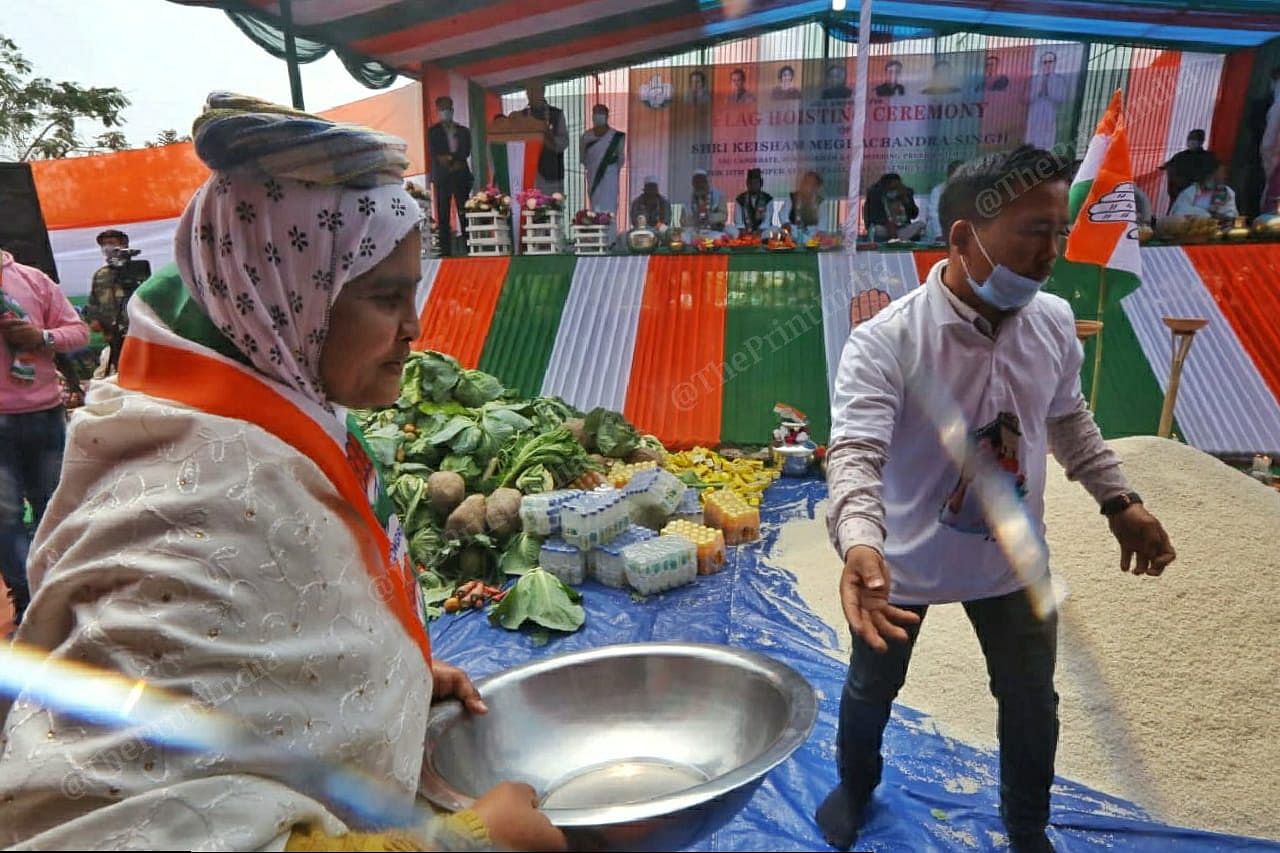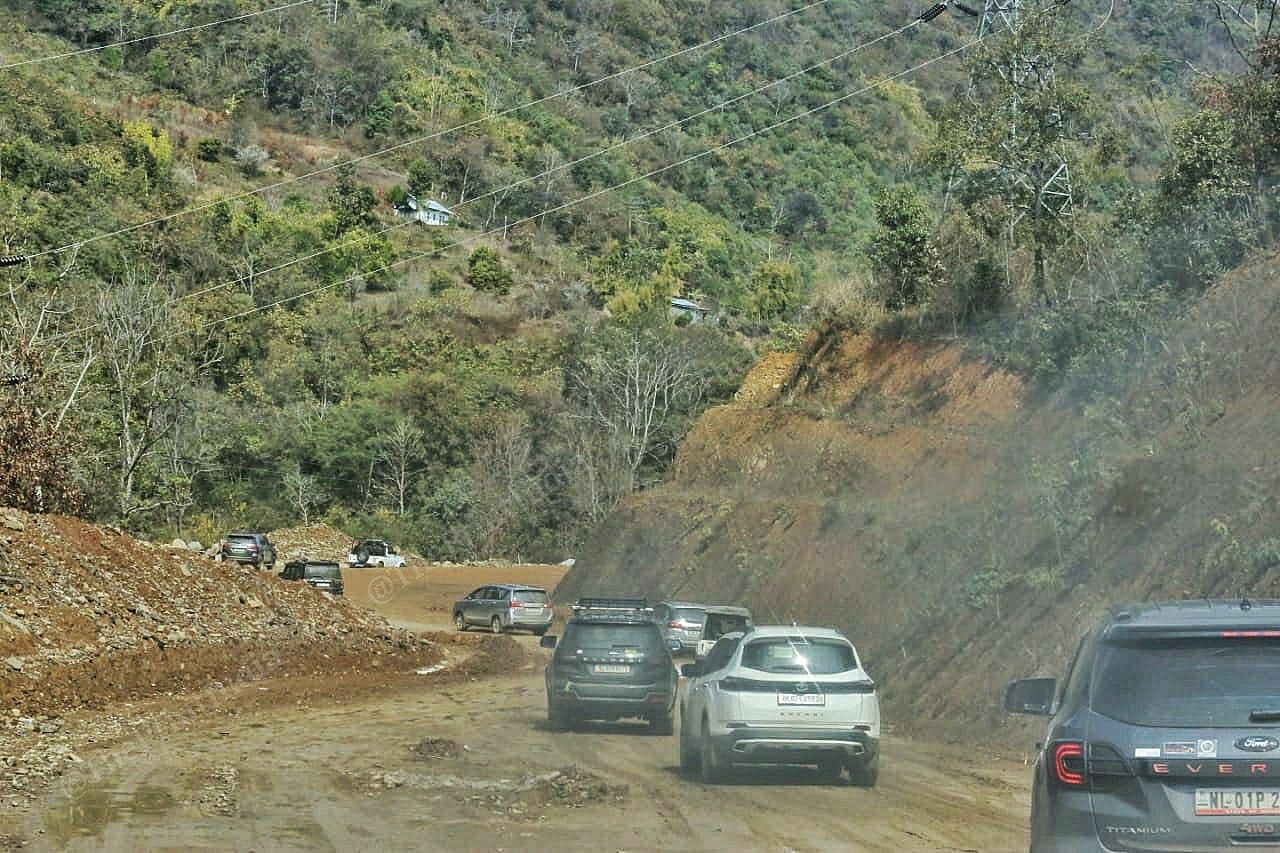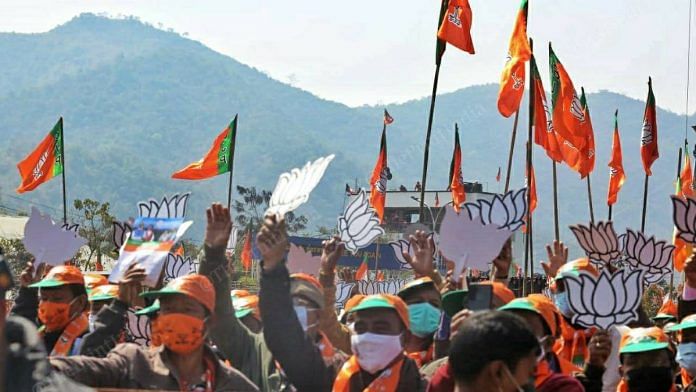Imphal: Vociferous protests demanding the removal of Armed Forces Special Powers Act (AFSPA) and calling for the implementation of the Inner Line Permit, and the nagging problem of insurgency, something that claimed the lives of an Assam Rifles commanding officer and his family at the hands of militants in November — Manipur has been in the headlines for sometime now.
However, as Manipur goes to the polls in the first stage of the assembly elections Monday (the second stage of polling is on 5 March), these issues haven’t taken centrestage in the poll campaigning of the various parties in the fray.
Geographically, hilly areas comprise 90 per cent of the Northeastern state, largely inhabited by tribals, while the ethnic Meitei group dominates the valley areas, which make up 10 per cent of the total land area.
While Meiteis make up 53 per cent of the population, tribals — which primarily include the Nagas (24 per cent) and the Kuki-Zo (16 per cent) — constitute 41 per cent.
Much of Manipur’s political landscape has been marked by differences between these various ethnic groups. Adding to this is an unstable political culture characterised by defections.
Competing promises of development and a massive influx of money in politics are important factors too.
A longstanding separatist insurgency as well as clashes between various insurgent groups, however, has always cast a shadow on the state’s affairs.
ThePrint lists the various factors to explain how electoral politics have played out in the state.
Also read: Defections, flailing leadership, pockets of hope — how Congress ‘khubak’ declined in Manipur
Violent insurgency & AFSPA
Insurgency has been a main issue in the state from even before it had attained statehood in 1972.
The decades from 1960 saw the rise of the United National Liberation Front (UNLF), People’s Revolutionary Party of Kangleipak (PREPAK) and People’s Liberation Army of Manipur (PLA) — separatist groups that claim that the merger of Manipur with the Union of India had been a “forced” one. Adding to the mix were the tribal militias — the Naga and Kuki insurgent groups.
The most significant among the Naga groups is the National Socialist Council of Nagaland (Isak-Muivah), which arose from the Naga movement for self-determination in the Naga inhabited areas of the Northeast. They demand a united homeland for Nagas — the ‘Greater Nagalim’ — including Naga-inhabited areas in Assam, Arunachal Pradesh and Manipur.
The group continues to hold tremendous sway in the Naga dominated hill areas of Manipur — particularly Ukhrul. In fact, the Tangkhul Naga village of Somdal in Manipur has been the birthplace of many insurgent leaders, including NSCN (I-M) general secretary Th. Muivah.
Meanwhile, the root of the Kuki insurgency in the state can be traced back to the 1950s, when the Kuki National Army (KNA) was formed to protect the rights and interests of the Kukis against “incursions” by both the Meiteis and the Nagas.
Manipur, since the time it was merged with India in 1949, has been witness to violent flare ups between these groups, including the Naga-Kuki clashes that took place in the 1990s.
The whole of Manipur was declared a “disturbed area” in 1980 and the AFSPA imposed, entitling security forces some special powers.
The Act, however, gained notoriety in the state over instances of alleged excesses by security forces. More significant among them was the infamous 1987 counter-insurgency operation, codenamed ‘Bluebird’, in Senapati district, wherein “many men were maimed, tortured and women raped”.
Then in 2004, two years after Congress’ Okram Ibobi Singh rose to power, there was the horrific rape and murder of 32-year-old Manorama, allegedly by paramilitary soldiers, which prompted the famous protest by 12 women, who disrobed in front of the historic Kangla fort.
While the issue of the AFSPA’s removal, a longstanding demand in the state, finds a mention in the manifestos of the Congress, the Naga People’s Front and National People’s Party, its absence from the ruling BJP’s manifesto has attracted criticism.
The BJP, however, at different points this election season, has referred to these issues to target its competitors.
BJP national president J.P. Nadda, for instance, is reported to have said, “Insurgency and AFSPA had always been important issues. However, in recent times, we have been able to bring insurgency to a bare minimum which ushered in a state of peace and normalcy in the state.”
As a counter, the Congress in Manipur has maintained that the state government under Okram Ibobi Singh, whose regime witnessed a peak in insurgency activity, was responsible for the repeal of AFSPA in seven assembly constituencies straddling Imphal.
The problem of insurgency also underlined Amit Shah’s recent visit to the hill district of Churachandpur, home of many Kuki groups, where the Union home minister vowed to end the militancy problem if the BJP comes back to power.
Incidentally, it was in this district last November that five Assam Rifles soldiers, including a commanding officer and his wife, were killed in an ambush by militants.
Dominant Meitei politics
Of the 60 assembly seats in Manipur, the valley areas are represented by 40 seats, while the hills are represented by 20.
As a result, the Meiteis, who reside in the valleys, have wielded more political influence in the state — a fact that is at the root of the prevailing hill-valley divide.
For instance, out of the 12 chief ministers elected in the state since 1963, only two were from (Naga) tribal communities (Yangmasho Shaiza and Rishang Keishang).
Till 2017, the valley constituencies had primarily voted for Congress and,in some cases, regional parties like the Manipur People’s Party, an offshoot of the Congress.
In the valleys, clan affiliations play a significant role in terms of voting behaviour.
The Meiteis mainly comprise the Meitei Hindus, the Meitei Sanamahi (those following the traditional Meitei religion, which existed prior to the erstwhile princely kingdom’s conversion to Hinduism) and the Meitei Muslims or Pangals as they are known.
Researchers Oinam Bhagat and A. Bimol Akoijam in their 2002 paper “Assembly Election: Trends and Issues” had noted that “for the Meiteis, the voting pattern is not based on whatever religious divide that exists among them”. Instead, “in the valley, to some extent, clan lineage plays a crucial role” and there are “tendencies where people of a clan demographically distributed in a cluster (particularly in rural areas) tend to vote for a candidate close to their kin”.
In some parts of Imphal and in rural areas, the clans reside in their respective leikais or neighbourhoods.

In a Congress rally ThePrint visited last week in Wangkhem constituency in Thoubal district, there was a collective show of support for a candidate. During the rally, women from the same leikai were seen walking into the rally in single files carrying bamboo baskets with offerings of rice, flowers, fruits and vegetables. This royal era practice, called athenpot thinba, is typically a demonstration of support for the candidate.
Interestingly, Akoijam, an assistant professor at JNU, told ThePrint that over the years the Rashtriya Swayamsevak Sangh (RSS), which has existed in the state since the 1950s, have become more active amongst Meiteis in the valleys.
“But the Meiteis are a group of revivalists, so there’s an anti-brahmanical ethos, although the RSS is trying to present it as the same conglomeration,” he said.
“I don’t think though that hardcore Hindutva project will work here,” he added.
The revivalist movement in Manipur started in 1944, aimed at preserving Meitei heritage and reconstructing Metei identity.
Tribal politics
Unlike in the valley areas, the Congress wasn’t the dominant party in the hills.
Three perceived “anti-hill” bills in 2015 — Protection of Manipur Peoples Bill, the Manipur Land Revenue and Land Reforms (Seventh Amendment) Bill and Manipur Shops and Establishments (Second Amendment) Bill — passed in the aftermath of the Meitei-led protests for Inner Line Permit contributed to some discontentment towards the Congress.
The Okram Ibobi Singh Congress government’s move to deny the entry of NSCN(I-M) leader Th. Muivah into Manipur in 2010 also created disaffection.
Yet, the Congress still remains a contender, past assembly election results indicate.
Some assembly seats in the hill areas have been won in the past by the Congress and the state-based offshoots of the Congress like the Manipur People’s Party. The National People’s Party, the Naga People’s Front and independents have also won in the hills.
Then, in the 2017 assembly polls, the BJP managed to win five hill seats, a first for the party, while the Congress wrested nine seats.
Bhagat and Akoijam in their paper say that “the groupings based on tribal identity played a crucial role in the hills”.
Akoijam of JNU told ThePrint that “underground groups” wield considerable influence in these areas when it comes to voting.
“The mainstream political parties can resist underground influence but are less capable of doing the same thing in the hills,” he said. “For instance, the Naga issue is being propped up by the underground groups. But, it doesn’t necessarily indicate the popularity of the Naga issue,” he added.
The competitive development agenda
Ahead of the Assembly elections, the contesting political parties have consistently brought up the issue of development in Manipur.
Political instability, the state’s troubles with insurgency as well as the difficult hill terrain has meant that the state has scored low on economic indicators.
The 2020-2021 Economic Survey report for the state revealed that per capita income remains well below the national average.
Development in the hills has particularly lagged behind in terms of road connectivity and access to healthcare, further accentuating the hill-valley divide.
In an attempt to garner more support in the hills, the BJP in September last year revived its ‘Go To Hills’ outreach campaign — an initiative to bring state government benefits to people in the remote areas.
BJP leaders in multiple speeches have also propounded on how they have “bridged the hill-valley divide”.

In his rallies in Imphal, Prime Minister Narendra Modi has claimed that the “double-engine” BJP government under the Chief Minister N. Biren Singh transformed Manipur from a “blockade state” into one ready with routes for international trade.
In his address, Modi was referring to the indefinite economic blockade that had been called by the United Naga Council in 2016 following the controversial formation of seven new districts.
Meanwhile, former CM Okram Ibobi Singh of the Congress has countered the BJP’s claims of development in his rallies, saying most such projects had been initiated under his regime, from 2002 to 2017.
Money power and defections
Another factor that has coloured Manipur politics has been constant defections of politicians.
Bhagat and Akoijam in their paper note that the “change of party loyalty, shifting alliances, both in the individual and collective levels, are frequent and ruthless” since Manipur attained statehood in 1972.
There were, the paper notes, “as many as eight chief ministers, with frequent changes of guard, on 18 occasions”.
In the last five years too, a series of defections has plagued the Congress, which ended up losing 15 of its 28 legislators to other parties.
The reason, experts say, is that political ideologies within the realm of electoral politics seldom hold ground in the state.
Instead, what is crucial is “money, personality and gun culture”, says Pradip Phanjoubam, editor of Imphal Review of Arts and Politics.
Akoijam also added, “The flow of money has increased [in this elections]. This is huge and unprecedented. Primarily, it is from the BJP, which has scaled up its investment, so others are forced to follow suit.”
In ThePrint’s travel through the state ahead of the assembly polls, it was evident that these various faultlines have far from been bridged during the five-year-long BJP government under N. Biren Singh.
But, with the Congress still struggling to regroup, the jury remains out on whether the state will see a change of guard.
(Edited by Saikat Niyogi)
Also read: Congress open to alliance with BJP’s partner & Manipur rival NPP, says ex-CM Ibobi Singh



